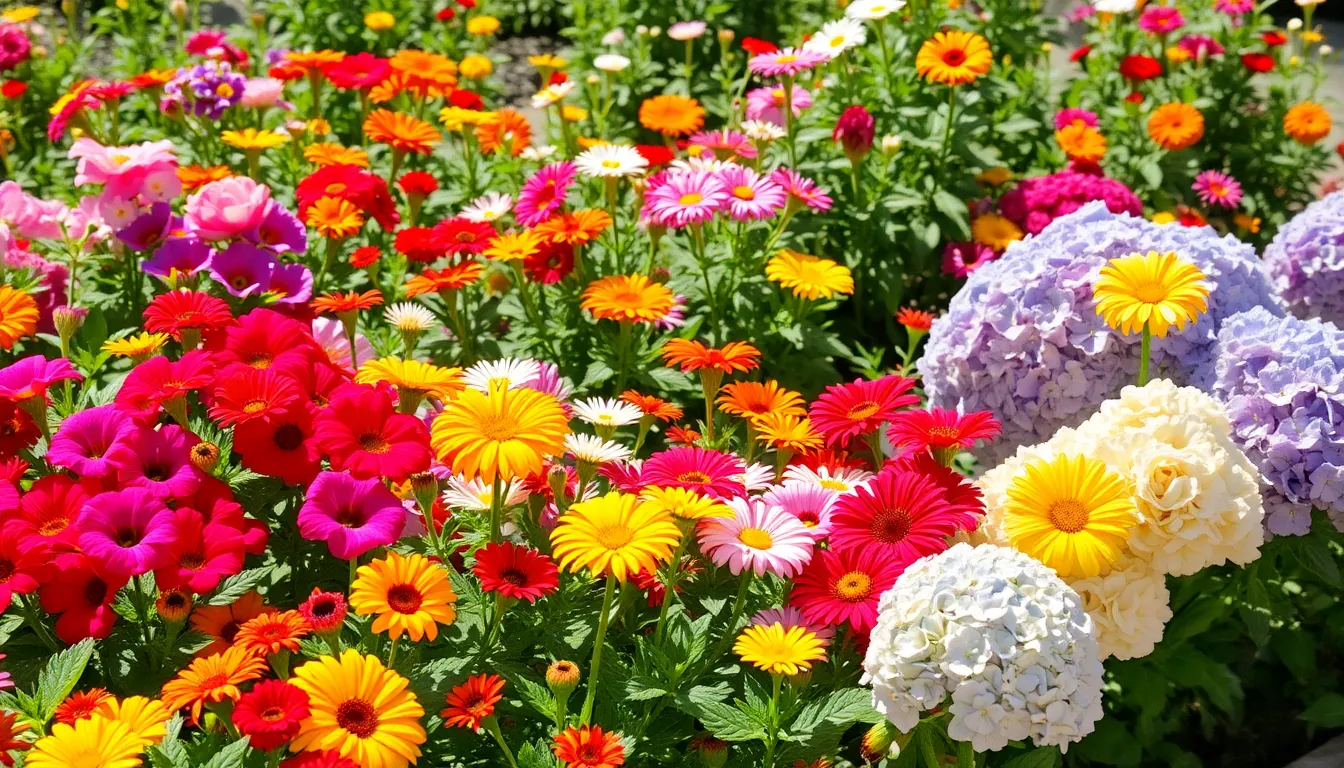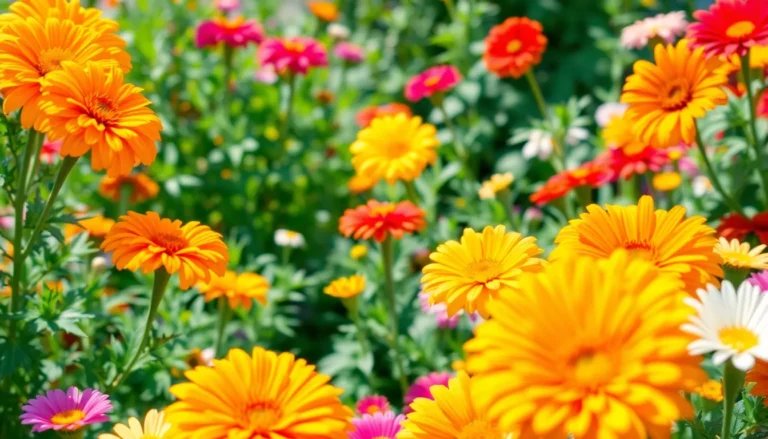
How to Plant a Flower Garden: Transform Your Yard into a Colorful Oasis
Imagine stepping into your yard and being greeted by a riot of colors and fragrances that make even the most seasoned florist green with envy. Planting a flower garden isn’t just about digging holes and tossing in seeds; it’s a delightful journey that transforms an ordinary space into a vibrant oasis. Whether you’re a seasoned gardener or a curious newbie, the joy of nurturing blossoms is irresistible.
But wait! Before you dive headfirst into the soil, let’s talk strategy. With the right tips and a sprinkle of humor, you’ll be well on your way to cultivating a floral masterpiece that’ll have neighbors peeking over the fence. Get ready to unleash your inner horticulturist and create a garden that not only blooms but also brings a smile to your face. After all, who wouldn’t want to be the proud owner of a flower garden that even bees would buzz about?
How To Plant A Flower Garden
Creating a flower garden involves more than planting seeds. It’s an engaging experience that transforms outdoor spaces into vibrant landscapes. Successful flower gardening requires a solid understanding of plant selection, soil preparation, and maintenance techniques.
Choosing the right flowers is crucial. Consider factors like climate, sunlight, and soil conditions when selecting plants. Popular choices include annuals such as petunias and marigolds, as well as perennials like daisies and hydrangeas. Each flower adds unique colors and textures.
Soil quality significantly impacts growth. Prepare the soil by testing its pH and nutrient levels. Adding organic matter, such as compost, improves soil health and promotes drainage. Properly aerated soil fosters strong root systems.
Watering practices greatly influence flower success. Water deeply but infrequently, ensuring that roots reach deeper into the soil. Early morning is often the best time to water, as it reduces evaporation and keeps foliage dry.
Fertilizing flowers supports growth. Organic fertilizers, like bone meal or fish emulsion, provide essential nutrients. It’s important to follow recommended application rates to avoid nutrient burn.
Pest management is another vital aspect. Regular monitoring for pests such as aphids and caterpillars can prevent infestations. Utilizing natural predators or applying insecticidal soap offers effective solutions for pest control.
Planning for seasonal changes is also essential. Understanding the bloom cycles ensures the garden maintains color throughout the year. Combining early, mid, and late bloomers creates a dynamic display.
Ultimately, flower gardening fosters creativity. Each gardener’s vision can lead to unique combinations and arrangements. With careful planning and dedication, anyone can cultivate a beautiful flower garden that attracts both pollinators and admiration.
Choosing the Right Flowers

Selecting the right flowers plays a key role in the success of a flower garden. Understanding the differences between annuals and perennials, along with considering climate conditions, ensures vibrant blooms.
Annuals vs Perennials
Annuals bloom for one growing season. Flowers such as petunias and marigolds provide an instant splash of color. Unlike annuals, perennials return year after year. Daisies and hydrangeas are examples that add lasting beauty. Gardeners often mix both types for a continuous display. Combining these options creates variety and longevity in the garden.
Climate Considerations
Climate significantly influences flower selection. Regions with colder winters necessitate hardier varieties. Conversely, warmer climates allow for diverse options. It’s advisable to check local conditions before planting. Growing zones defined by the USDA offer valuable insights. Climate-appropriate flowers flourish and require less maintenance. Awareness of sunlight and moisture levels aids in making the right choices. Proper selection leads to a thriving and vibrant garden.
Preparing Your Garden Space
Creating a flower garden starts with effective preparation of the space. Proper strategies ensure a successful and vibrant display.
Selecting the Location
Choosing the right spot is fundamental. Sunlight exposure significantly affects flower growth. Aim for a location that receives at least six hours of direct sun daily. Near pathways or windows also adds aesthetic appeal. Elevation helps with drainage, so avoid low areas where water might accumulate. Assess soil conditions too; well-draining, nutrient-rich soil promotes healthy plants.
Soil Preparation
Soil preparation plays a crucial role in garden success. Testing soil pH determines its acidity and fertility levels. A pH of 6 to 7 is typically ideal for flowering plants. Amending the soil with organic compost enhances texture and nutrients, improving flower growth. Tilling the soil loosens it, allowing roots to penetrate easily. Incorporating organic matter supports microbial activity, benefiting plant health. Remove rocks and debris to create a clean planting environment.
Planting Techniques
Planting techniques significantly influence the success of a flower garden. Proper spacing and depth ensure plants thrive and flourish.
Spacing and Depth
Spacing varies based on flower type and growth habits. Annuals typically require less space, at around 6 to 12 inches apart, while perennials need 12 to 24 inches. Planting at the right depth is crucial for stability; most flowers should be planted at a depth equal to their root ball. Gardeners should ensure that roots rest comfortably in the soil, avoiding overly deep or shallow planting. Proper spacing not only promotes air circulation but also discourages disease. Observing the specific needs of each flower variety enhances overall garden vitality.
Watering Guidelines
Watering techniques affect flower health and growth. Consistent moisture is vital, with deep soaking preferred over frequent light watering. Gardeners should aim for approximately 1 inch of water per week, adjusting based on rainfall and temperature. Early morning watering minimizes evaporation while preparing plants for the day ahead. Avoiding overhead watering helps reduce fungal diseases by keeping foliage dry. Utilizing a soaker hose or drip irrigation ensures targeted hydration. Regularly checking soil moisture levels informs any adjustments needed in the watering schedule, supporting robust flower development.
Maintenance of Your Flower Garden
Maintaining a flower garden involves consistent care in areas like fertilization and pest control.
Fertilizing Tips
Use organic fertilizers to nurture flower growth effectively. Applying a balanced fertilizer every 4 to 6 weeks encourages vibrant blooms. Consider options such as compost, bone meal, or fish emulsion for a natural boost. Spread fertilizer evenly around plants, avoiding direct contact with stems to prevent burning. Water after fertilizing to help nutrients penetrate the soil. Test soil annually to adjust nutritional needs based on results. Monitor plants for signs of nutrient deficiency, such as yellowing leaves, which may indicate a need for additional fertilization.
Pest Control Strategies
Implementing integrated pest management ensures a healthy flower garden. First, monitor plants regularly for early signs of pests. Identify common pests, like aphids, slugs, and spider mites, to target solutions effectively. Introduce beneficial insects, such as ladybugs and lacewings, which naturally control pest populations. Use organic insecticidal soaps or neem oil for treatment when infestations occur. Regularly remove debris and damaged foliage to prevent pest breeding. Encourage biodiversity by planting companion flowers that repel pests while attracting pollinators.
Conclusion
Creating a flower garden is an enriching experience that offers both beauty and satisfaction. With the right planning and care anyone can transform their outdoor space into a colorful haven. By selecting suitable flowers understanding soil requirements and implementing effective maintenance techniques gardeners can ensure a thriving garden that flourishes year after year.
Embracing the journey of flower gardening allows for creativity and personal expression. Whether it’s the cheerful blooms of annuals or the dependable return of perennials each choice contributes to a vibrant landscape. As they nurture their gardens gardeners not only enhance their surroundings but also foster a deeper connection with nature.



